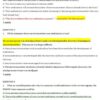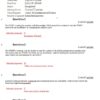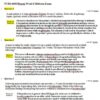Description
NURS 6630N Final Exam Week 11 – Approaches to Treatment Spring Term
75 out of 75 points
- All drugs that lead to addiction increase __________________in the ventral striatum, which is also called the _______________.
- A patient with chronic back pain has been prescribed a serotonin-norepinephrine reuptake inhibitor (SNRI). How does the PMHNP describe the action of SNRIs on the inhibition of pain to the patient?
- Karen completes the Epworth sleepiness scale and scores abnormally high. She is diagnosed with narcolepsy. The PMHNP prescribes a wake-promoting agent that is a weak dopamine transporter antagonist. Which medication did the PMHNP prescribe?
- Which of these characteristics does NOT meet the criteria for probably Alzheimer’s dementia?
- Neal is complaining of restless leg syndrome and insomnia. Which first-line medication should the PMHNP prescribe to treat both?
- A nursing student asks the PMHNP about the difference between the use of stimulants in the treatment of ADHD and the abuse of stimulants in substance-use disorders. Which is the correct response?
- The PMHNP prescribes pregabalin (LYRICA) for a patient with chronic pain. How does pregabalin work to reduce pain?
- A patient addicted to heroin is receiving treatment for detoxification. He begins to experience tachycardia, tremors, and diaphoresis. What medication will the PMHNP prescribe for this patient?
- The PMHNP is caring for a patient who reports excessive arousal at nighttime.
- What could the PMHNP use for a time-limited duration to shift the patient’s brain from a hyperactive state to a sleep state?
- The PMHNP is assessing a 49-year-old male with a history of depression, post-traumatic stress disorder (PTSD), alcoholism with malnutrition, diabetes mellitus type 2, and hypertension. His physical assessment is unremarkable with the exception of peripheral edema bilaterally to his lower extremities and a chief complaint of pain with numbness and tingling to each leg 5/10. The PMHNP starts this patient on a low dose of doxepin (Sinequan). What is the next action that must be taken by the PMHNP?
- Antipsychotics are doses at a level that blocks ________% of D2 receptors. A 63-year-old patient presents with the following symptoms. The PMHNP determines which set of symptoms warrant prescribing a medication? Select the answer that is matched with an appropriate treatment.
- The PMHNP is assessing a patient she has been treating with the diagnosis of chronic pain. During the assessment, the patient states that he has recently been having trouble getting to sleep and staying asleep. Based on this information, what action is the PMHNP most likely to take?
- The PMHNP wants to prescribe Mr. Barber a mood stabilizer that will target aggressive and impulsive symptoms by decreasing dopaminergic neurotransmission. Which mood stabilizer will the PMHNP select?
- Jordan is diagnosed with obsessive compulsive disorder. He has been trialed on several different SSRIs and is currently on high dose sertraline. He reports an inability to carry out responsibilities because of an obsession with handwashing.
- Which is the best treatment option for Jordan?
- A patient with chronic insomnia asks the PMHNP if they can first try an over-the-counter (OTC) medication before one that needs to be prescribed to help the patient sleep. Which is the best response by the PMHNP?
- A patient recovering from shingles presents with tenderness and sensitivity to the upper back. He states it is bothersome to put a shirt on most days. This patient has end stage renal disease (ESRD) and is scheduled to have hemodialysis tomorrow but states that he does not know how he can lie in a recliner for 3 hours feeling this uncomfortable. What will be the PMHNP’s priority?
- An opioid-naive patient is taking MS Contin (morphine sulfate) to treat his pain that is secondary to cancer. Under what circumstances would the PMHNP order naloxone (Narcan) IM/SQ?
- The PMHNP is selecting a medication treatment option for a patient who is exhibiting psychotic behaviors with poor impulse control and aggression. Of the available treatments, which can help temper some of the adverse effects or symptoms that are normally caused by D2 antagonism?
- The PMHNP is discussing dopamine D2 receptor occupancy and its association with aggressive behaviors in patients with the student. Why does the PMHNP prescribe a standard dose of atypical antipsychotics?
- A patient presents with psychotic aggression. Which treatment option is best for a patient presenting with psychotic aggression due to impaired top-down cortical control and excessive drive from striatal hyperactivity?
- Which of the following is considered as a disruptive/impulse control behavior?
- A patient is being prescribed bupropion and is concerned about the side effects. What will the PMHNP tell the patient regarding bupropion?
- The PMHNP is treating a patient with depression and fibromyalgia. The PMHNP chooses to prescribe a treatment that may help treat the patient’s fibromyalgia and depressive symptoms. Which medication is the PMHNP likely to choose?
- Mrs. Kenner is concerned that her teenage daughter spends too much time on the Internet. She inquires about possible treatments for her daughter’s addiction. Which response by the PMHNP demonstrates understanding of pharmacologic approaches for compulsive disorders?
- Sandra complains of constipation after being on quetiapine (SEROQUEL) for several weeks. Constipation is likely caused by the binding of quetiapine (SEROQUEL) to which receptor?
- The PMHNP evaluates a patient presenting with symptoms of dementia. Before the PMHNP considers treatment options, the patient must be assessed for other possible causes of dementia. Which of the following answers addresses both possible other causes of dementia and a rational treatment option for Dementia?
- A 14-year-old patient is prescribed Strattera and asks when the medicine should be taken. What does the PMHNP understand regarding the drug’s dosing profile?
- Which of the following anticonvulsants increases serotonergic neurotransmission and GABAergic transmission, while decreasing glutamatergic neurotransmission?
- Naltrexone (Revia), an opioid antagonist, is a medication that is use for which of the following conditions?
- Why does the PMHNP avoid prescribing clozapine (Clozaril) as a first-line treatment to the patient with psychosis and aggression?
- A patient with hypersexual disorder is being assessed for possible pharmacologic treatment. Why does the PMHNP prescribe an antiandrogen for this patient?
- Methylphenidate, amphetamine, and cocaine are alike because all three _____________________.
- The PMHNP is caring for a patient who experiences too much overstimulation and anxiety during daytime hours. The patient agrees to a pharmacological treatment but states, “I don’t want to feel sedated or drowsy from the medicine.” Which decision made by the PMHNP demonstrates proper knowledge of this patient’s symptoms and appropriate treatment options?
- Sharon is a 56-year-old female that presents to the clinic with pain after suffering a back injury several years ago. The patient states she feels a tingling sensation in her legs. What type of pain is Sharon likely experiencing? (NURS 6630N final exam)
- You decide to start a patient on lurasidone (LATUDA). Which of these counseling points is correct?
- You have been consulted to evaluate a patient who presents with symptoms of dementia. The patient is experiencing memory deficit, aphasia, apraxia, and agnosia. Which treatment option is best for this patient?
- A patient with a new diagnosis of diabetic peripheral neuropathy is switch from sertraline (ZOLOFT) to duloxetine (CYMBALTA). The patient asks why they are switching treatment. What is the best response?
- The PMHNP understands that slow-dose extended release stimulants are most appropriate for which patient with ADHD?
- Which medication is an irreversible inhibitor of aldehyde dehydrogenase that creates a negative and aversive response following ingestion of alcohol?
- A patient with chronic insomnia and depression is taking trazodone (Oleptro) but complains of feeling drowsy during the day. What can the PMHNP do to reduce the drug’s daytime sedating effects?
- Daniel is a 33 year old patient with ADHD and multiple comorbidities: mood disorder, alcohol abuse, ADHD, and nicotine dependence. Which comorbidity should be treated first?
- The PMHNP understands that varenicline (CHANTIX) is an effective way to assist patients with smoking cessation. Why is this medication effective for these patients?
- A 71-year-old male patient comes to an appointment with his 65-year-old wife. They are both having concerns related to her memory and ability to recognize faces. The PMNHP is considering prescribing memantine (Namenda) based on the following symptoms:
- The nursing staff asks the PMHNP for additional education regarding the treatment of agitation in dementia patients. Which of the following is correct?
- The parents of a 7-year-old patient with ADHD are concerned about the effects of stimulants on their child. The parents prefer to start pharmacological treatment with a non-stimulant. Which medication will the PMHNP will most likely prescribe?
- Which of the following is a true statement regarding the use of stimulants to treat attention deficit hyperactivity disorder (ADHD)?
- Parents of a 12-year-old boy want to consider attention deficit hyperactivity disorder (ADHD) medication for their son. Which medication would the PMHNP start?
- Antihistamines may cause side effects such as blurred vision, constipation, memory problems, and dry mouth. This is due to the _______________ effects of antihistamines.
- A group of nursing students seeks further clarification from the PMHNP on how cholinesterase inhibitors are beneficial for Alzheimer’s disease patients. What is the appropriate response?
- The PMHNP is consulted to evaluate a patient in a long-term care facility that is having difficulties participating in group therapy each morning after breakfast. What is the likely cause of excessive daytime sleepiness?
- The PMHNP is working with the student to care for a patient with diabetic peripheral neuropathic pain. The student asks the PMHNP why SSRIs are not consistently useful in treating this particular patient’s pain. What is the best response by the PMHNP?
- A patient calls the clinic to ask about an over-the-counter sleep aid. What is the best response?
- The PMHNP prescribes gabapentin (Neurontin) for a patient’s chronic pain. How does the PMHNP anticipate the drug to work?
- The parents of a 10 year old girl diagnosed with ADHD ask if the PMHNP can prescribe something to help their daughter’s ADHD that is not a stimulant. Which of the following responses is correct? (NURS 6630N final exam)
- An 80-year-old female patient diagnosed with Stage II Alzheimer’s has a history of irritable bowel syndrome.
- Which cholinergic drug may be the best choice for treatment give the patient’s gastrointestinal problems?
- A 75-year-old male patient diagnosed with Alzheimer’s disease presents with agitation and aggressive behavior. The PMHNP determines which of the following to be the best treatment option?
- Even though both of these medications are useful in the treatment of ADHD, their actions are different. Atomoxetine is a selective ______________________ reuptake inhibitor, while bupropion is a selective __________________ reuptake inhibitor.
- The novel neurotransmitter adenosine is responsible for the sleep-wake cycle by increasing throughout the day and diminishing during night. Which of the follow is an antagonist of adenosine?
- The PMHNP is assessing a patient who has expressed suicidal intent and is now stating that he is hearing voices and sees people chasing him. The-PMHNP identifies these symptoms to be associate with which of the following?
- The PMHNP is treating a patient for fibromyalgia and is considering prescribing milnacipran (Savella). When prescribing this medication, which action is the PMHNP likely to choose? (NURS 6630N final exam)
- A young patient is prescribe Vyvanse. During the follow-up appointment, which comment made by the patient makes the PMHNP think that the dosing is being done incorrectly?
- The PMHNP is performing a quality assurance peer review of the chart of another PMHNP. Upon review, the PMHNP reviews the chart of an older adult patient in long-term care facility who has chronic insomnia. The chart indicates that the patient has been receiving hypnotics on a nightly basis. What does the PMHNP find problematic about this documentation?
- The PMHNP is caring for a patient with chronic insomnia. The PMHNP wishes to prescribe a drug with an ultra-short half-life. Which drug will the PMHNP prescribe?
- Brandon is a non-compliant patient that presents to the clinic asking for help with his alcohol dependence. The PMHNP evaluates the patient and determines a long-acting injection that blocks the mu-receptors would be the best treatment option for Brandon. Which medication should the PMHNP prescribe? (NURS 6630N final exam)
- The PMHNP is assessing a female patient who has been taking lamotrigine (Lamictal) for migraine prophylaxis. After discovering that the patient has reached the maximum dose of this medication, the PMHNP decides to change the patient’s medication to zonisamide (Zonegran). In addition to evaluating this patient’s day-to-day activities, what should the PMHNP ensure that this patient understands?
- The PMHNP has been ask to provide an in-service training to include attention to the use of antipsychotics to treat Alzheimer’s. What does the PMHNP convey to staff?
- The PMHNP is evaluating a 7 year old pediatric patient for the treatment of ADHD. The PMHNP decides to prescribe a medication that is selective for alpha-2A receptors that has a lower incidence of sedation and hypotension. Which agent did the PMHNP prescribe?
- The PMHNP is assess a patient who will be receiving phentermine + topiramate combination (QSYMIA). QSYMIA would be contraindicated in which patient?
- Individuals who suffer from an addiction often increase the dose of medication to achieve the desired effect. The need to increase the dose to reach the safe effect is due to __________________. The PMHNP is caring for a patient on risperidone (Risperdal). Which action made by the PMHNP exhibits proper care for this patient?
- What will the PMHNP most likely prescribe to a patient with psychotic aggression who needs to manage the top-down cortical control and the excessive drive from striatal hyperactivity? (NURS 6630N final exam)
- A patient diagnosed with obsessive compulsive disorder has been taking a high-dose SSRI and is participating in therapy twice a week. He reports an inability to carry out responsibilities due to consistent interferences of his obsessions and compulsions. The PMHNP knows that the next step would be which of the following?
- Which statement best describes a pharmacological approach to treating patients for impulsive aggression?
- The PMHNP is caring for a patient with chronic insomnia who is worrie about pharmacological treatment because the patient does not want to experience dependence. Which pharmacological treatment approach will the PMHNP likely select for this patient for a limited duration, while searching and correcting the underlying pathology associated with insomnia?






